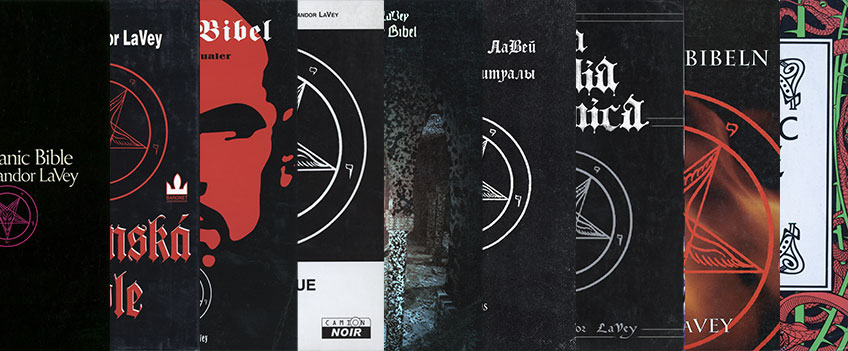

Addendum to “So It Was Written: The History of The Satanic Bible”
by Magistra Peggy Nadramia, High Priestess of the Church of Satan
THE REVIEWS
As those of us who are writers, editors and publishers know too well, receiving that first box of fresh, new copies of a book is an exciting moment whose satisfaction is fleeting in the face of the need to publicize and distribute our titles. LaVey’s office staff went into high gear to get copies in the right hands and reviews started to appear widely in newspapers and trade publications. LaVey dutifully reported these onward for a few months but as The Satanic Bible’s first year in print wore on, the task became overwhelming.
In a letter to Peter Mayer from June 1970, LaVey eagerly relates his satisfaction with an extended article that was scheduled to appear the next month in the magazine section of the London Daily Telegraph. A photo of LaVey and mention of The Satanic Bible had just appeared that month in Penthouse, “the English equivalent of Playboy,” according to LaVey, and he’s impatient for Avon to step up their distribution into the United Kingdom in the wake of this publicity. By November of that year, LaVey was again contacting Mayer and attempting to list the many outlets where The Satanic Bible and the Church of Satan were being reviewed and discussed: “National Enquirer... San Francisco Chronicle... The Lawton Constitution... The Forty-Niner...” More books on modern occultism were appearing and including LaVey: “The Second Coming by Arthur Lyons... Today’s Witches by Suzy Smith... Witchcraft In America Today by Emile C. Schurmacher...” LaVey was still an object of local interest and he reports two television appearances, “The Mid-Morning Show” in San Francisco, and an “ABC-TV mini-documentary on witchcraft.”
There had been a rather horrific murder that year with occult and cannibalistic overtones [Stroup and Baker, the “Yellowstone Murder”] and LaVey was consulted by the Associated Press for their wire story. His perspective was interesting: “...no matter what we do to rebuke any reports which attempt to tie us with Stoup [sic] and Baker, Manson and others who profess Satanic inspiration for their illicit actions, the public will believe what they want to. So we might just as well accustom ourselves to the fact that we’ll sell some books as the result of such dubious testimonials and therefore include this sort of publicity under the category of ‘promotion.’ I didn’t mean to embark upon a diatribe on the ‘misunderstood, good-guy Satanist,’ but I did want to mention this piece and felt you might wonder what possessed me to include it in a list of publicity items which are in drastic contrast to this one.” He didn’t always feel this way; LaVey’s growing irritation with the public perception of Satanism came to a head in the early 80’s when he sued the author and publishers of Michelle Remembers.
In 1973 members of the Church of Satan were asked to pitch in and send clippings of local reviews directly to the publicity department at Avon. They continued to send them in to the Church itself for decades.
One of the more interesting reviews from the time The Satanic Bible was published, appeared in the regular Books column of the Sunday St. Louis Post-Dispatch, December 27, 1970. The reviewer was Deirdre LaRouche and she covered three different books on Satanism; the column was titled, “Satan: The Modern Liberator.” Here’s what she said:
“ ‘The Satanic Bible’ by Anton LaVey approaches Satanism from a vastly different angle. LaVey is the founder and high priest of the Church of Satan, a legally functioning and licensed religion with a membership of some 7,000 people, a regular schedule of meetings and a surprisingly non-secretive attitude towards its ceremonies and teachings. The main theme of this ‘bible’ seems to be that repression and frustration of man’s desires and needs are the underlying causes of most, if not all, of the ills that afflict society today. LaVey feels that the repressive influences of established religion, with its constant emphasis of the inherent inability of its members to meet God’s high standards of behavior and morality, are responsible for the current state of rebellion so apparent in today’s youth. How can we expect our children to conform to the mores of a society whose Christian ethic is constantly being compromised and manipulated to suit the needs, political and social, of its self-indulgent and war-oriented ‘older generation,’ he asks. What the young people of today are seeking, LaVey feels, is an honest religion, barren of hypocrisy, martyrdom and false humility, and offering instead pride in one’s being, acknowledgement of one’s carnality and full enjoyment of all aspects of life on this Earth of ours.
“Anton LaVey is, from his writing and from descriptions of him by others, a brilliant man who became thoroughly disillusioned with all so-called ‘good Christians’ at an early age. As a carnival organist and as a San Francisco Police photographer, he saw more than he cared to of the seamier side of human nature. He developed an abiding hatred of the phrase ‘t was God’s will,’ particularly when applied to the sufferings and deaths of innocent people who had been victims of the violence that seethes constantly under the placid and too often unconcerned eyes of our ‘God-fearing’ citizenry.
“According to LaVey, the Church of Satan does not celebrate the anti-Christian black mass, nor require of its initiates that they blaspheme, desecrate holy articles, nor subject themselves to degrading and degenerate sexual practices in order to become members. The rituals observed are not aimed at destroying other religions, but at creating in the congregation a sense of freedom of self, awareness of one’s responsibilities to self and to others, and liberation from society-imposed attitudes which hamper the full development of one’s potential as a human being. In a very real sense, the message of ‘The Satanic Bible’ is that of Walt Whitman’s ‘Song of Myself’ ... ‘I celebrate myself, and sing myself...’ and I suspect that, although its existence may be deplored by many, this book and its adherents will be around for a long time to come.”
THE HARDCOVER
After a lively but ultimately disappointing series of exchanges in 1969 with William Targ of Putnam’s [see my main article, “So It Was Written”] regarding a hardcover version of The Satanic Bible, both Avon and LaVey appear to have shelved the effort until August 1971, when LaVey wrote a letter to publisher Lyle Stuart, whose company also did business as University Books. “I am delighted to hear that you will be publishing my Satanic Bible in hardcover. I have long been an admirer of your literary successes and your obvious know-how when it comes to reaching the masses... We receive increasing numbers of letters asking about the availability of a ‘permanent,’ ‘library,’ ‘formal,’ etc. edition of the Bible, so I believe the time is as right as it can be... I am convinced that The Satanic Bible will, in due time, become the primer for a popular movement destined to virtually obliterate existing Christian mumbo-jumbo. From what I have heard of you, I couldn’t think of a better Devil’s advocate with whom to traffic.”
LaVey received a prompt response from Stuart’s vice-president, Robert Salomon, who tersely confirmed the company’s intention to publish the hardcover and complained that they’d been waiting for a contract from Avon for six months. Things went quiet, but by the end of 1972, Salomon wrote again to inform LaVey of their plans to bring out The Satanic Rituals in the same format. Both hardcovers appeared simultaneously the next year, and LaVey received his author’s copies in September of 1973. When the Church of Satan attempted to purchase additional stock of the hardcover Satanic Bible in June of 1976, their check was returned with a note confirming that there were no longer any copies available.
Swiftly thereafter, in August of the same year, The Satanic Bible was under consideration for another hardcover edition by the Robert Collier Book Corporation in New Jersey; they contemplated putting out a new edition with an updated introduction and distributing it alongside Avon’s paperback version by direct mail to individual readers. Collier did ultimately contract with LaVey to distribute The Satanic Bible. Their proposed advertising campaign focused on the empowerment the book could bestow on anyone, including the adherents of mainstream religions: “We are not in any way suggesting that you reject the teachings of the Holy Bible or the teachings of your own particular faith and replace them with the teachings of THE SATANIC BIBLE because then the scale would be simply tipped off-balance in the opposite direction... We are, however, saying that using them together will balance your life and make it richer, fuller, happier, filled with more fun and purpose than it could possibly be by learning only one side of the story, for ‘Half-Truths are as good as lies,’ and ‘The Truth (The Whole Truth) will set men free.’” This diatribe was accompanied by a drawing of Satan holding The Satanic Bible and shaking hands with a Biblical figure holding the Holy Bible. Ordering information and several 800 numbers were also included. Collier proposed selling the hardcover for $9.98 with a shipping cost of eighty-five cents. This updated hardcover reprint never appeared.
In 2015, an omnibus hardcover of both The Satanic Bible and The Satanic Rituals was published by private arrangement with William Morrow, an imprint of HarperCollins-Avon, the present-day company that acquired Avon Books via Hearst Publishing. This edition was planned as part of a year-long celebration of the 50th anniversary of the founding of Anton LaVey’s Church of Satan in 1966. It premiered in Washington, DC at a conclave held there exclusively for Church of Satan members. Like the first hardcover, this edition comprises a photo-enlargement of the pages from the paperback version, and is likewise out of print. The edition ran less than 1,200 copies and is also a rare and expensive collector’s item.
THE DEDICATIONS
The deletion of the extended Dedications in The Satanic Bible took place in 1977 with its 12th printing, and before the separation of Anton LaVey and Diane Hegarty. In 1978, in the Hoofnotes section of The Cloven Hoof (Volume X, #2, pages 2-3, Whole Number 72), LaVey had this to say: “Some of you have wondered why the dedication page of The Satanic Bible has been omitted from new editions. Thereby hangs a tale. When the author listed those names a decade ago, they were known in varying degrees to the public, some being much more obscure than others. Since original publication, several of those mentioned gained new fame of cultic proportions. To retain those names would, to a fresh reader, appear Epimethean, especially as they appeared *before* the current updated introduction, which informs the reader of relevant societal changes which have come about since original publication of The Satanic Bible. It was also thought that because The Satanic Bible has served as the basic text on Satanism, the original list of names was far too limited. It would necessitate a separate volume to list all those who have lived and served as devil’s advocates, thus lending support and inspiration to the author’s creation.”
In conversation, LaVey related that it was actually the result of a mishap on Avon’s part. According to his biographer Blanche Barton, LaVey had requested that the publisher remove the Dedications in The Satanic Rituals due to the last-minute inclusion of Michael Aquino among the other names therein. Avon instead deleted the Dedications from The Satanic Bible; LaVey was not particularly upset by this, and his thoughts on the subject were related via that note we included above. Barton also had this to say: “There was never any discussion of omitting the ‘For Diane’ from the SB. Dr. LaVey respected the memory of their love, and the part she had played during the foundational years of the Church, even if she no longer did. He was indeed a romantic.” “For Diane” remains in current editions of The Satanic Bible.
THE FOREIGN EDITIONS
As the Church of Satan and The Satanic Bible began gaining notoriety worldwide, LaVey was naturally interested in foreign language editions of his book, and so were many of the members and friends he had in other countries. He questioned his editor at Avon, Peter Mayer, who passed him on to their rights manager, Alice Bosk. In a letter from November of 1972, she explained that Avon did not own any translation rights to The Satanic Bible or retain any financial interest in same, and that the author’s contract stipulated that he had retained them. However, Avon had agents representing their properties in many countries and could agent the rights for LaVey if he would be amenable, and a separate agreement reached and signed.
During the next few months, letters from interested publishers began coming in to the office at the Church of Satan and were duly passed on to LaVey’s literary agent, Mike Hamilburg, but LaVey was not hearing back. He decided to contact Alice Bosk at Avon and take her up on the offer for Avon to represent the book to foreign publishers, as he wasn’t getting any feedback from his American agent. “We have had considerable foreign press in the last six months and anticipate at least two more large photo stories in major European magazines, by the same people who did the photo work for the Look and Time cover stories on us. Their work has already appeared in seven or eight large magazines in Europe and Latin American countries, and the mail we have subsequently received on the coverage to date would seem to indicate a goodly amount of interest.”
In fact, the Hamilburg agency’s representative overseas, Charlotte Wolfers, was working diligently to market the book to a number of foreign houses. Mike Hamilburg might be forgiven for holding back on LaVey at this point as the news was not good. In June of 1973, a response finally came in just as LaVey was considering this new deal with Avon: “We received the following message from our agent in London: ‘The Satanic Bible has been rejected in this country by Mayflower, Hodders, Sphere, Pan, and is currently with Tandem Books [publishers of The Second Coming by Arthur Lyons - PN]. The Satanic Rituals: has been rejected here by Pan and is also currently with Tandem. They have both been rejected by Rizzoli in Italy. You forwarded a request from them but, as I say, they turned it down. In Holland they are turned down by Arbeiderspurs, Bruan and Zoon, and Bert Bakker, and will now go to Zuid Hollandsche. In France: no news yet.’”
At this point, LaVey was informed by Charlotte Wolfers herself that she was working as Avon’s agent in England and it might be best for all if he just left the foreign rights negotiations in the hands of the Hamilburg/Wolfers agencies.
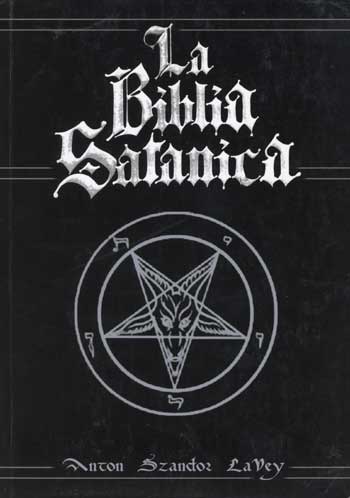
Among the publishers who were contacting the Church of Satan directly with an interest in acquiring the rights to translate The Satanic Bible, were Edizioni Mediterranee Roma and Longanesi and Co. in Italy, Ediciones Martinez Roca and Ediciones Picaso in Spain, Bestseller Importadora de Livros in Brazil, and Kanki Books in Japan. The first Spanish language versions of The Satanic Bible and The Satanic Rituals were contracted by Ediciones Martinez Roca in 1974, and appeared in 1975, translated by José Maria Cañas. It is extremely rare to find a copy.
There are references in the correspondence to unauthorized Mexican editions of The Satanic Bible and The Satanic Rituals. In 1977, local research had turned up references to Rituales Satánicos and Biblia Satánico by Anton LaVey in the card catalog of the Modesto, CA library. Both books had been borrowed and probably never returned, as frequently happens with library copies of LaVey’s books. The staff at the Church of Satan began calling Spanish-language bookstores up and down the coast; some claimed they had seen the book, but no one had a copy. The library’s index reference provided a publisher’s name and their address, which was promptly forwarded on to Avon. Avon’s rights department wrote to this address and received a response back from a little insurance agency in Mexico, protesting their innocence and avowing they didn’t publish books at all. We’ve since concluded that these were the legitimate paperback editions published by Ediciones Martinez Roca, printed and distributed in Mexico where the company maintained a division.
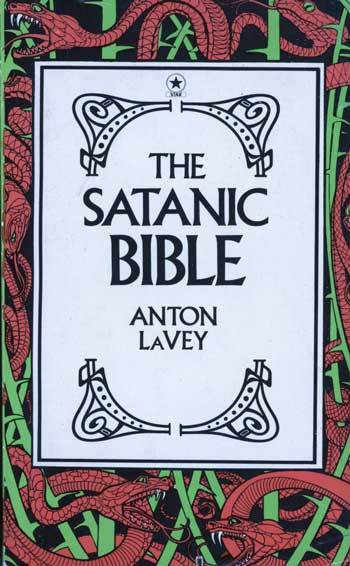
LaVey did ultimately have Avon negotiating his British foreign rights, resulting in a sale in 1976 of The Satanic Bible to a British publisher, W. H. Allen, who created the edition with the legendary “lizard-green” cover. W. H. Allen & Co. had a long list of alternate/affiliate company names, including A. Howard, Wyndham, Richard Clay and The Chaucer Press. The British Satanic Bible appeared under their imprint as “a Star Book,” which, I suppose, it always will be. The publishers were interested in having LaVey come over to the United Kingdom for a promotional tour; LaVey responded enthusiastically: “Judging from the mounting interest in Satanism, your timing seems to be perfect. I would definitely be interested in coming to England, as you proposed. Many promotional possibilities come to mind, when I consider the wealth of advantages in your country for same. I’m sure my appearance at various ‘Satanic’ locations (I can think of many) would generate interest and be fun for all involved.”
At the time the book was accepted and placed in W. H. Allen’s queue for publishing, LaVey was eager to replace Michael Aquino’s Introduction and mentioned several times that Burton Wolfe was finalizing an updated version; for some reason — perhaps it wasn’t completed in time? — W. H. Allen wound up using the original Wolfe Introduction from 1969. The British edition went out of print after an unknown number of copies were printed, but is not difficult to find in collector’s markets.
Sphinx published a Danish edition in 1987, Satans Bibel & Rituale, translated by Frater Edwin.
A Czech translation by Josef Rauvolf (Satanská Bible) was published in 1991 by Reflex Publishing in Prague. Reflex was founded in 1990 and is chiefly a magazine. Rauvolf is known for his work translating such Beat Generation authors as William S. Burroughs and Jack Kerouac.

In 1990, Carl Abrahamsson contracted with HarperCollins-Avon and LaVey to publish his Swedish translation via Psychick Release. He renewed the rights in 1995 and ultimately published it under the auspices of his own Looking Glass Press. This attractive trade paperback included an author photo by Nick Bougas.
In the wake of LaVey’s death in 1997, a number of small foreign publishers grew interested in publishing translations of The Satanic Bible, as well as the rest of LaVey’s body of work, and approached the Church of Satan with their inquiries. Magus Peter H. Gilmore quickly became the unpaid and largely unrecognized liaison between these entities and HarperCollins-Avon, advising on the material and its presentation, clarifying the use of symbols and graphics, and reviewing the contracts in consultation with the original American publisher. He continues to function in this role today. Bootleg editions were being dumped on the public immediately following LaVey’s passing, so management of new translations became a key priority.
What follows is a list of foreign translations which is as complete as we can make it, given the propensity today to flagrantly disregard copyright as well as common courtesy.
1990: Danish / SphinX Publishers / Satans Bibel & Rituale / Frater Edwin, translator
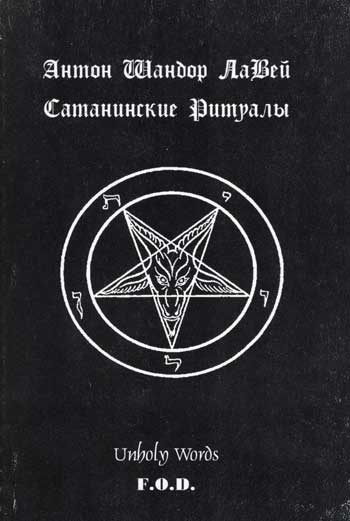
1997: Russian / Unholy Words F.O.D. / Sataninskaya Bibliya
1998: Spanish / Faesan, Inc. / Riverbank, CA / La Biblia Satánica
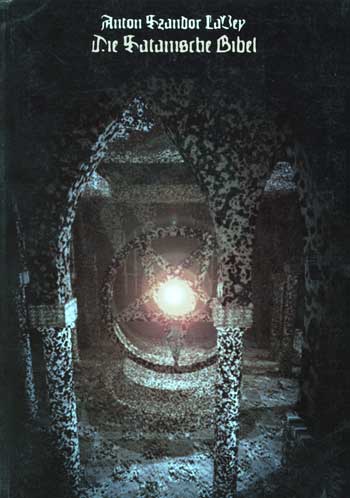
In 1999, Ingrid Meyer of Second Sight introduced her own long-awaited German translation of The Satanic Bible (Die Satanische Bibel). She followed this up in 2003 with an omnibus edition that included The Satanic Rituals (Die Satanischen Rituale), and introduced an elaborate boxed set of same in 2007, which included an audio CD of the books being read in German, and a poster of the symbol of Baphomet. Yet another edition of the omnibus appeared in 2013 under the Index Verlag imprint.
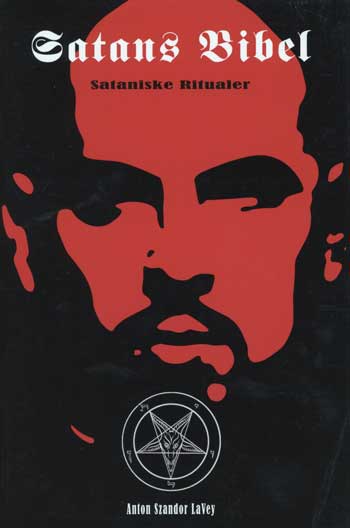
1999: Polish / Fox / Biblia Szatana
1999: Bulgarian / Unknown / Sataninska Biblija / Atanas Semniazov, translator
2001: Estonian / R. Jaanson / Saatanlik Piibel
2003: Czech / Baronet / Satanská Bible
2004: Danish / LuciFer Publishing via Lennart Sane Agency / Satans Bibel and Satans Ritualer / Frater Edwin, translator
2004: Norwegian / Wolf’s Lair via Tönnheim / Den Sataniske Bibelen / Marius Huseby, translator
2006: French / Camion Noir / La Bible Satanique
2007: Portuguese / HellOutro Enterprises / A Bíblia Satânica
2007: Italian / Arcana / La Bibbia di Satana
2007: Finnish / Voimasana / Saatanallinen Raamattu / Paula Merensuo, translator
2008: Danish / SphinX Publishers / Omnibus Edition: Satans Bibel & Rituale / Frater Edwin, translator
2008: Spanish / Martinez Roca / La Biblia Satánica
2008: Latvian / Severins / Sātana Bībele
2010: Russian / Ishi Press / Sataninskaya Bibliya / Elena Borichko, translator
2010: Portuguese / Saida de Emergencia via Associacao Portuguesa de Satanismo / A Bíblia Satânica
2012: Turkish / Altikirkbes Yayinlari / Seytanin Kitabi
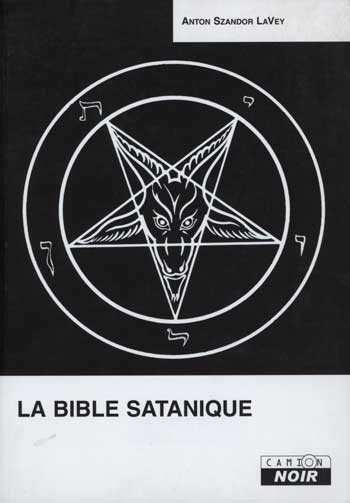
LaVey’s titles are frequently pirated and published through print-on-demand sites for reasons upon which we can only speculate. This includes bootlegs of the translations listed above, and in these cases, the Introductions are often swapped out for the writings of amateurs whose understanding of Satanism would be greatly improved by actually reading the book they’d just stolen.

THE INTRODUCTIONS
In June of 1971, after The Satanic Bible had been on the stands for a year-and-a-half, Anton LaVey decided he wanted to replace Burton Wolfe’s Introduction with one written by Michael Aquino. In a letter to his editor, Peter Mayer, LaVey said, “The new Introduction will be far more timely, in view of the changes that have taken place in the Church of Satan in the last five years. The format used for the new one is such that the material won’t soon become dated, as did the first.” Mayer responded promptly that he’d be in touch with Avon’s production department about getting the new Introduction in place.
LaVey heard back in February, 1972, from Mary Traina, a production manager at Avon, with page proofs for the new Aquino Introduction. A few corrections were requested:
“Such theorists as Pythagoras, Hegel, Lovecraft and Crowley...” was changed to “Pythagoras, Hegel, Spencer and Compte.”
“There are no collective policy statements save the Crowley admonishment: ‘Do What Thou Wilt shall be the Whole of the Law” became “There are no collective policy statements save ‘self-deceit is the gravest of all ‘sins.’”
“An American descendant of Georgian, Alsatian, and Roumanian Gypsies...” was adjusted to “An American of Georgian, Alsatian, and Roumanian Gypsy descent.”
Shortly after Michael Aquino’s departure from the Church of Satan, in July 1975, Peter Mayer received another request for a change of Introduction. “We would like the Introduction deleted, as it is pretty much out of date... this is just a formal request for your files.” Mayer was none-too-pleased with yet-another swap of Introductions, and quickly responded, “I certainly never agreed to drop the introduction to The Satanic Bible when we go back to press, only to consider it. I will do my best at that time to satisfy you... but publishing just isn’t that simple.”
When corresponding with the folks at Collier Books in June of 1976, during the negotiations for a possible new hardcover, the Introduction was again a point of concern: “the [original] introduction by Wolfe should be used, with the following corrections: ... reference to ‘old dark victorian house’ must be deleted, as no activities of any sort are held there any longer and all this sort of description does is create headaches for the staff who have to put up with cranks and vandals... magic formula of ‘nine parts outrage to one part social respectability’ should be reversed to read ‘nine parts social respectability to one part outrage.’”
Rather than delete the Introduction altogether, LaVey submitted an updated version by Burton Wolfe in November of 1976: “We didn’t discuss the possibility of Avon doing a new intro for the next printing... [but] Burton did the original intro and it is still being quoted from, whereas the revised one [by Michael Aquino, PN] that is presently being used hasn’t had a single quote and we have had absolutely no feedback on it. Burton has retained a lot from his original, while updating and ‘beefing up’ certain portions.” The updated Wolfe Introduction finally appeared in printings of The Satanic Bible in 1977.
In November of 2004, HarperCollins-Avon approached Magus Peter H. Gilmore, current High Priest of the Church of Satan, and requested a new Introduction. Gilmore’s “Opening the Adamantine Gates” made its first appearance in The Satanic Bible in January of 2005 and has been there since. His essay mentions his own discovery of The Satanic Bible and Satanism, and provides a detailed biography of the author as well as a complete list of LaVey’s other works, recordings, biographies, appearances in major media outlets and in documentaries. Gilmore relates in descriptive detail the ways in which LaVey’s various life experiences formed and impacted his creation of the Satanic philosophy and worldview. “We Satanists owe him our gratitude for symbolically opening the adamantine gates of Hell, by giving form and structure to a philosophy that names us as the Gods of our own subjective universes... He dethroned the seeking of external saviors and championed responsibility for all of one’s actions and the resultant consequences.”
THE AUTHOR PHOTO
When Anton LaVey was asked for an author photo for the cover of The Satanic Bible, he was able to choose from an embarrassment of riches, as they say, thanks to the many photo sessions in which he’d participated over the previous years. Photographers were clamoring to take pictures at the infamous Church of Satan, and in September 1968 LaVey allowed John Hendricks to conduct a photo session and interview with himself and his family at the Black House. In lieu of a modeling fee, LaVey agreed to accept a couple of Hendricks’ photos which he could use as he liked, and it was one of these that he provided to Avon at their request.
When Avon was about to release the fourth printing of The Satanic Bible in June of 1971, their legal department had to delay distribution due to a complaint they had received from Hendricks, saying that the author photo was being used without his knowledge or consent.
“The discrepancy over the photograph of myself which appears on the back cover of The Satanic Bible came as a surprise to me, to say the least!” LaVey told Avon’s legal representative. He explained the agreement they’d made when arranging the photography session. “I said I would require at least one print of a photograph of myself to compensate for my time; the added incentive being provided by the new photograph, since the fee involved could have been obtained in a far less exhausting fashion.” LaVey provided a copy of his contract with Hendricks and added that he hadn’t been able to get in touch with him since the session of three years earlier.
It can be reasonably assumed that Hendricks was able to reach an agreement with Avon; his photograph has graced the cover for 50 years now.
YANKEE ROSE
The mysterious sign-off to The Satanic Bible, “Yankee Rose,” was missing from the 32nd printing which appeared in the early 1990’s. We were fortunate to be visiting Anton LaVey around this time and he predicted, correctly, that this edition would become a collector’s item, but he also offered a short-term solution: just rubber-stamp it in.
THE REPRINTS
“Good news!” Peter Mayer’s note in October of 1970 was short but conveyed a message Anton LaVey was happy to hear. “We went back to press for another 25,000 copies of the SATANIC BIBLE. The book is not selling like crazy, but it is selling steadily.”
This message about The Satanic Bible’s first reprint characterizes the book’s entire history as a publishing commodity. While LaVey naturally enjoyed the steady income the sales of the book would provide over the years, his main concern became keeping it in print and having it distributed to bookstores nationwide. Even today, when a box of Satanic Bibles reaches a bookstore, there’s always the chance an anonymous bookstore employee will take issue with it, shove it into storage, neglect to refill the shelves, or just throw it in a dumpster. So when the news arrived that 25,000 fresh copies had become available, LaVey informed Mayer, “...the San Francisco dealers have a Hell of a time keeping it in stock, and from what I hear from members throughout the rest of the country, the same applies elsewhere... everyday we receive a great number of calls and letters from people who have scoured their cities for it, but can’t find it in any of their local bookstores... If we can just get copies in the stores the dealers don’t have the least difficulty selling them.”
Eight months later, in June of 1971, a fourth printing was waiting to ship out while LaVey and Avon’s legal department cleared up the question of the author photo, discussed elsewhere in this article.
In the summer of 1975, LaVey contacted Avon to request a replacement of the Introduction by Michael Aquino (“...it is pretty much out-of-date...”), and received the disheartening message from Peter Mayer’s office that there was only “a slim chance” of The Satanic Bible going back to press. Coming on the heels of LaVey’s first major venture into Hollywood via his work on “The Devil’s Rain,” this must have felt akin to a disaster. Having his book go out of print just as his name began to become known in another major medium would have been unsettling.
Hence LaVey’s joyous letter to Mayer the following April, “to express my delight at seeing the new printing of The Satanic Bible. Thanks for keeping the fires stoked.” But a few short months later, in September of 1976, rights manager Rosanne Leacy was hearing from LaVey in response to a message he’d received that sales had again dropped. This response had a different tone and was on the order of a complaint; it included a lengthy list of local stores whose management claimed it always sold out promptly, and emphasized once more the difficulty stores seemed to have in obtaining it: “IF AND WHEN they can get the two books they sell very fast... If San Francisco is any example of the rest of the country, it’s no wonder sales have dropped — there’s none to buy!” This same letter references the fact that at this point, The Satanic Bible had been through 11 printings, doing well “in spite of the fact that they have had to make it strictly on their own, i.e. no promotion by Avon and sluggish distribution.”
Accompanying this letter was a copy of a note that a Church of Satan member had received in the package along with her book when she’d mail-ordered it through Avon. “GOD IS WATCHING YOU!” it proclaimed, along with a little hand-drawn cross. “I trust the orders for the two books are not being sabotaged in the shipping department... it would be kind of funny if it weren’t for the fact that it might be cutting into our pocketbook via similar notices to bookdealers.”
Stock at Avon did sometimes hover at quite low numbers, but The Satanic Bible has never gone out of print. By the early 1980’s the Satanic Panic gave the book’s sales a large shot in the arm, so it was indeed a mixed blessing. As many present-day Satanists trace their interest in LaVey and Satanism back to the stern warnings they received as teens — remember the Law of the Forbidden? — LaVey could certainly be justified in his conviction that as long as they spelled his name right, publicity is publicity.
You can read Magistra Nadramia's original essay here: So It Was Written: The History of The Satanic Bible by Anton Szandor LaVey


Portrait
We Are Legion
A Moment In Time
This slideshow requires JavaScript.
SUPPORT THE
CHURCH OF SATAN!
There are many ways you can support the Church of Satan. Visit our support page to learn how.
navigation-topper



